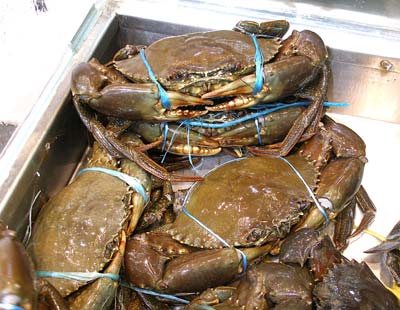Hot pot. Some sat that the hotpot from Chongqing is the beset and most addictive, perhaps because it is awash with chillis. The Chinese hotpot is a great meal. The ones we ate in Beijing involved sitting round a table on which stood a pot. Into this a block of frozen stock was dropped with a bump, hot water poured over it and the heat turned up under it. The block quickly melted and provided a stonkingly hot spiced, very red broth called hong tang. To the table where delivered slivers of meats, fish, prawns (US: shrimp), noodles, mushrooms and one or two other completely unidentifiable things. These would be dipped in, dragged through the boiling stock for a few seconds and then popped into the mouth, slightly like shabu-shabu in Japan. I gather there is a milder version of the stock called yuan wei and I do slightly wish that we had had that one. Strange. I don’t mind the brains and duck bowel but I think sometimes that my need for chillis is decreasing.

The mud crab or mangrove crab. A type of swimming crab found around the northern coasts of tropical Australia and making very good eating. It is found in the muddy bottoms around mangroves in estuaries and shallow bays. Only males are fished, usually using pots. They make very good eating indeed, although we found their musculature completely different from European crabs, with the meat not lifiting from the claws or from the carapace in a single succulent mouthful, but very flaky, requiring a great deal of thorough scraping to get at it. It is definitely worth the trouble as the flesh is remarkably sweet and well-flavoured. The colour of mud crabs will vary, as Denis Christie in Sydney Fish Market told me, depending on whether they have been caught in a sandy or muddy environments, those from mud being darker and greener. They are kept bound up when sold live, as they most frequently are, to prevent injury to other crabs. This crab, like so many others, has in the past been known as the black, brown of green crab, as well as the giant mud crab and, in error, the orange mud crab. When asked if he was going anywhere for his holidays, Stewart, one of the guides at the Bloomfield Lodge in Weary Bay in Northern Queensland replied that he was just going to stay put and fish a few mud crabs. A happy man.
.jpg)
Is numbing, spicy hot sauce of Sichuan, Chinese cuisine. The buzzing sensation
caused by the presence of the molecule, hydroxy alpha sanshool in the sichuan
pepper gives rise to the name for the unique spicy hot sensation of málà sauce.
The sauce is comprised of both chili peppers and powder, sichuan peppercorns, a
salty and spicy paste of soybeans and fermented broad beans, rice, and spice
called “bouban paste”, garlic, cloves, star anise, fennel, black cardamom,
ginger, salt, and cinnamon, simmered in beef tallow and oil. Variants and proportions change according to
region and personal tastes, but kencur or “sand” ginger is a common
addition. While the origins of málà sauce
are not certain, it is believed it was developed in the late 19th to
early 20th centuries in Chongqing to deter spoilage and mask the
tinge of blood and strong odor of organ and inferior cuts of meat served to
waterfront workers. However dubious its
origins, the popularity of numb taste málà sauce has only increased and it
is served now in many regions of around the world.

Cassava. Manioc. Yuca. Fleshy, starchy tubers with tough brown skin and crisp white flesh, originally from Brazil but now widely cultivated. There are two types, sweet and bitter. Avoid the bitter one. Throughout the Amazon basin there are 26 varieties, each thriving under different conditions. The process of making it into flour or tapioca removes the toxins.
Kencur. A plant similar to ginger but with a distinctive flavour. The rhizome is smaller and more shrivelled than that of ginger. It is used both medicinally and in the cuisine of much of the Indian Subcontinent and South East Asia, but not of Thailand where is it used only medicinally.
Kencur. A plant similar to ginger but with a distinctive flavour. The rhizome is smaller and more shrivelled than that of ginger. It is used both medicinally and in the cuisine of much of the Indian Subcontinent and South East Asia, but not of Thailand where is it used only medicinally.